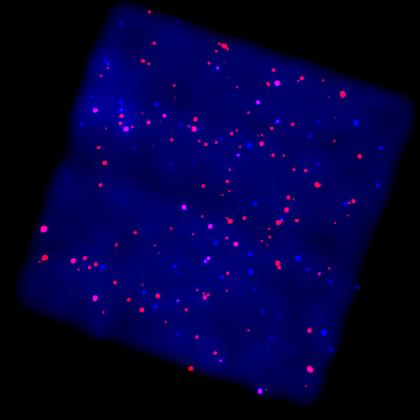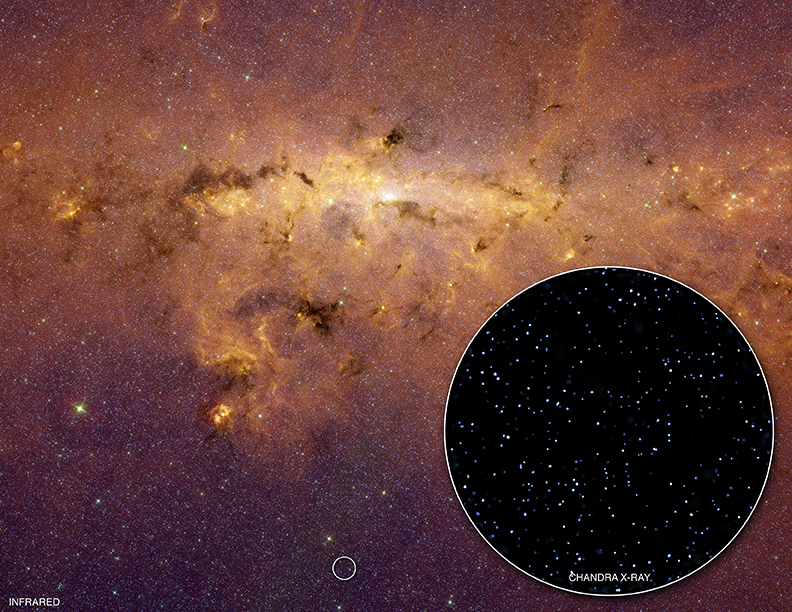This image shows an infrared view from the Spitzer Space Telescope of the central region of the Milky Way, with a pullout showing a Chandra image of a region located only 1.4 degrees away from the center of the Galaxy.
The so-called Galactic ridge X-ray emission was first detected more than two decades ago using early X-ray observatories such as HEAO-1 and Exosat. The ridge was observed to extend about two degrees above and below the plane of the Galaxy and about 40 degrees along the plane of the galaxy on either side of the galactic center. It appeared to be diffuse.

This Chandra image marks the deepest X-ray look at the "zone of avoidance" -- a region of space behind which no optical observation has ever been taken because thick clouds of dust and gas in the spiral arms of the Milky Way block visible radiation. X-rays, along with certain radio and infrared wavelengths, can penetrate this barrier, and Chandra provided the best look yet at what X-rays reveal. The diffuse blue emission is due to hot (ten million degree Celsius) gas concentrated along the plane of the Galaxy. Most of the pink and red objects sources in this image are believed to be active stars in our Milky Way galaxy. The blue objects, referred to as "hard" sources because they emit more energetic X-rays, are considered to be distant galaxies. Because astronomers were able to identify these objects as being well beyond the galactic plane, they were able to determine that the X-ray glow from the galactic plane comes not from individual sources, but from the hot diffuse gas. Chandra observed this region of the galactic plane in the constellation Scutum on February 25-26, 2000, with its Advanced CCD Imaging Spectrometer instrument for a total exposure time of 90,000 seconds. Credit: NASA/GSFC/K.Ebisawa et al.
One interpretation of the Galactic X-ray ridge is that it is emission from 100-million-degree gas. This interpretation is problematic because the disk of the Galaxy is not massive enough to confine such hot gas, which should flow away in a wind. Replenishing the gas would then be a problem, since plausible sources of energy such as supernovas are not nearly powerful enough.
A very deep Chandra observation, lasting for about 12 days, was used to study the nature of this ridge emission. The field was chosen to be close enough to the Galactic plane so that the ridge emission was strong, but in a region with relatively little absorption from dust and gas to maximize the number of sources that might be detected. A total of 473 sources were detected in an area on the sky only about 3% of the size of the full Moon, one of the highest densities of X-ray sources ever seen in our Galaxy.

Constellation Sagittarius. Color Code X-ray (Blue); IR (Yellow, Orange&Violet). Distance Estimate About 26,000 light years. Credit X-ray (NASA/CXC/TUM/M.Revnivtsev et al.); IR (NASA/JPL-Caltech/GLIMPSE Team)
It was found that more than 80% of the seemingly diffuse ridge of X-ray emission was resolved into individual sources. These are believed to be mostly white dwarfs pulling matter from companion stars and double stars with strong magnetic activity that are producing X-ray outbursts or flares that are similar to, but more powerful than the flares seen on the Sun. These stars are unrelated to the large-scale structures seen towards the center of the Spitzer image, which are probably caused by young massive stars.
The paper reporting these results appears in the April 30th issue of Nature. This work was led by Mikhail Revnivtsev from the Excellence Cluster Universe, Technical University Munich, in Garching, Germany and from the Space Research Institute, in Moscow, Russia. The co-authors were Sergey Sasanov of the Space Research Institute in Moscow, Russia; Eugene Churazov of the Max Planck Institute for Astrophysics (MPA) in Garching, Germany; William Forman and Alexey Vikhlinin from the Harvard- Smithsonian Center for Astrophysics and Rashid Sunyaev from MPA.






Comments